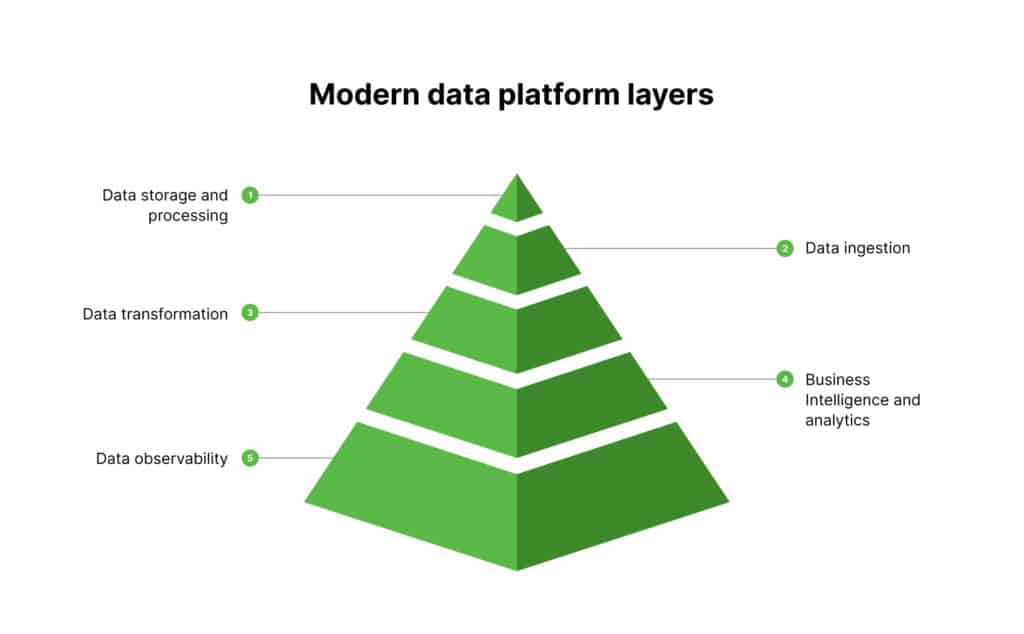
Data & AI Evangelist

Principal Data Architect
Subscribe to the newsletter
In the era of Big Data, organizations are faced with a deluge of data. The focus has shifted from data quantity to deriving actionable insights from this data. Here, a modern data platform (MDP) becomes indispensable, streamlining data access and analysis, and enabling organizations to generate insights and make informed decisions.
Data fuels digital transformation by creating opportunities for organizations to optimize operations and propel growth. However, with these opportunities comes the need to remain competitive. Business leaders know that future decisions will become more complex, driving the demand for data and analytics. Yet, as per a McKinsey report, only 8 percent of organizations truly excel in leveraging analytics to extract real value from data.
By investing in a modern data analytics platform, organizations can handle the volume, velocity, and variety of data and gain a competitive edge that has been missing all along.
Not sure about this investment? Through this blog, you will learn more about modern data platforms, the key layers of a MDP, and a step-by-step guide to streamline the process of data platform modernization within your organization.
What is a modern data platform: Understanding its concept
At its core, a Modern Data Platform (MDP), also sometimes called the modern data stack, is a set of cloud-based tools that work together to help organizations collect, store, process, analyze, and derive insights from large volumes of their data. These platforms are designed to handle diverse data types (structured, semi-structured, and unstructured data) from multiple sources.
MDPs are built on the foundation of cloud computing to allow organizations to leverage the power of big data and drive insights that inform strategic decision-making. However, as data expands in volume, velocity, and variety, modern data platforms provide a necessary framework to capture, store, manage, and analyze data, enabling organizations to extract actionable insights from their data assets.
Now, what makes a modern data platform truly modern?
A modern data platform can be considered truly “modern” if it meets the following characteristics:
- Architectural foundations are based on cloud-based platforms and services
- Provides solutions for extracting, integrating, and sharing all types of data
- Supports streaming data, real-time analytics, and batch data
- Includes unified data governance and security capabilities
- Provides effective self-service to a wide range of analytics and data users without dependencies on the data or IT team
- Supports agile data management
- Enhance security and resilience
- Provides flexibility to make data-driven decisions
The five essential layers of Modern Data Platforms
The foundation of modern data platforms lies in their cloud-based, service-oriented architecture, which supports scalability, flexibility, and efficiency in data management and analytics. A modern data platform comprises five layers that manage and analyze data efficiently. Each of these layers plays a vital role in modern data platform architecture.

Data storage and processing
The first layer of a modern data platform is storage, which involves solutions for storing data, such as a data warehouse, databases (SQL and NoSQL), and data lakes, which support data in different formats (both structured and unstructured).
Since businesses are transitioning to cloud-native solutions, which are taking over the market, businesses are offering efficient, inexpensive options for storing data relative to on-premises solutions. However, regardless of your option, data storage and processing are critical components that ensure data is efficiently managed, analyzed, and utilized to drive business insights and decision-making processes.
Data ingestion
The second layer of modern data platforms, also called as the data ingestion process, involves collecting data from multiple sources into a central location for further processing and analysis (based on accessible, accurate, and consistent data). Organizations are more likely to make business decisions from their analytics infrastructure. However, the value of this data is derived from how well the data is ingested.
Since data is ingested from different sources, such as mobile phones, the Internet of Things (IoT), and SaaS platforms, a robust data processing and integration solution serves as a foundation of effective data strategy. Batch processing and real-time processing (also known as stream processing) are two different forms of data ingestion that must be addressed to ensure that all data is efficiently handled and can be analyzed according to an organization’s timing requirements and priorities.
Data transformation
The third layer of a modern data platform, data transformation, involves refining, cleaning, and transforming the structure and format of data for analysis which enhances data quality and usability. The data transformation layer makes data useful for the next stage of its journey, that is, analytics.
Data transformation is associated with ETL (extract, transform, load) or ELT (extract, load, transform) procedures. ETL allows businesses to extract data from different sources, transform it, and then load it into the data warehouse. On the other hand, ELT transforms data after loading it into the data warehouse.
Further readings: Dive into the comparison of ELT and ETL.
Snowflake, Azure, BigQuery, Redshift, etc., are some common cloud-based data warehouses through which organizations perform large-scale data transformations.
Business Intelligence and analytics
Business Intelligence and analytics are the fourth layer of modern data platforms, and they involve accessing, analyzing, and transforming data. After data cleaning and organization, this layer converts data into attractive visualizations and intuitive dashboards to generate strategic decision-making and business operations. BI and analytics tools like Tableau, Power BI, and Looker allow business users to explore and analyze data, gain insights, and generate reports and visualizations to support business decisions.
Moreover, BI dashboards serve as self-service platforms, enabling users to explore data efficiently rather than just consuming tables, charts, and graphs.
Further readings: How to create a dashboard in Power BI for meaningful data visualization?
Data observability
The last layer of the modern data platform, data observability, ensures it functions smoothly and the data is reliable. Data observability is the ability to monitor, track, and understand the behavior of data within the data platform. This layer involves monitoring data quality, performance, and compliance to ensure data is accurate, reliable, and secure. Data observability tools provide visibility into data pipelines, workflows, and processes, enabling organizations to understand data lineage, ensure consistency of calculations and measures, and identify and troubleshoot issues proactively.
All these different layers of modern data platforms work together to form an ecosystem that enables an organization to leverage the power of its data to make informed, smart decisions and achieve its strategic objectives.
Why invest in a modern data platform? Business benefits
Since managing data manually is a frustrating exercise, businesses are turning to modern data platforms to gain a multitude of benefits. These benefits extend beyond basic data analysis, empowering businesses to drive innovation and growth. Let’s look at the advantages modern data platforms provide compared to a traditional data management approach.
1. Single source of truth
Poor data quality has impacted a lot of businesses. However, this issue can be effectively addressed through the implementation of a modern data platform, which provides a unified source of truth for data across all applications. This streamlines decision-making processes, ensuring accuracy, security, and visibility of data for all users throughout the organization.
2. More confidence in your data
Businesses, regardless of their size, highly emphasize data management and security. Owing to these concerns, modern data platforms offer a solution by providing improved data management, scalability, security, and faster data analysis. Moreover, these platforms also contribute to the generation of accurate and timely reports across all business functions. Increased confidence in data quality enhances business decision-making based on reliable insights into past performance and future possibilities.
3. Data-driven decision making
Modern data platforms enable businesses to collect, store, and analyze vast amounts of data from various sources. By harnessing this data, organizations can make informed, data-driven decisions, leading to improved operational efficiency and strategic planning.
4. Improved efficiency and productivity
With streamlined data management processes, businesses can automate repetitive tasks, reduce manual errors, and optimize workflows. This efficiency frees up resources and time, allowing organizations to focus on core activities and innovation.
5. Enhanced customer insights
Modern data platforms provide businesses with deeper insights into customer behavior, preferences, and sentiment. By understanding their customers better, organizations can tailor products, services, and marketing strategies to meet customer needs more effectively, ultimately driving customer satisfaction and loyalty.
Get started with your modern data platform transformation journey
Launching a modern data platform isn’t as easy as it seems, but taking the right steps at the right time can make it a smooth and hassle-free journey for your organization. We’ve broken down the key steps to help you kickstart your modern data platform transformation journey and set you on the path to data-driven success.
1. Assess your current state
Begin by comprehensively assessing your current data infrastructure, systems, processes, and capabilities. Evaluate your data environment’s performance, scalability, reliability, and security. Gather feedback from stakeholders and users to understand their pain points, requirements, and expectations.
2. Define your objectives
Clearly define your data platform transformation initiative’s goals, objectives, and desired outcomes. Determine what you aim to achieve, whether improving data accessibility, enhancing analytics capabilities, optimizing data governance, or driving innovation. Align your objectives with your organization’s strategic priorities and business needs.
3. Develop a roadmap
Create a roadmap outlining your data platform transformation journey’s steps, activities, and milestones. Break down the transformation process into manageable phases or iterations that you can tackle at a time. Also, figure out what needs to happen first, what’s most important, and what you can realistically achieve. Then, make sure to get the right people, budget, and time in place to get it done.
4. Select the right technologies
Figure out which tools and technologies are the best fit for your data strategy and goals. Consider factors like how scalable and flexible they are, how well they work with other systems, and if they’re easy to use and fit our budget. Explore multiple options for storing, processing, transforming, and analyzing your data and pick the ones that make the most sense for your business requirements.
5. Implementation and integration
Implement the selected technologies and tools according to the designed architecture. Develop data pipelines to ingest, process, transform, and analyze data. Set up automation and orchestration mechanisms to keep things running efficiently and smoothly. Also, make sure everything works seamlessly with your current systems and apps, so data can flow freely between them. Before going live, thoroughly test everything to make sure it’s accurate, reliable, and performing as expected.
6. Training and adoption
Make sure everyone in the organization gets the training and support they need to make the most out of the new data platform. Encourage a culture where decisions are based on data and people work together to find the best solutions. Teach everyone how to use the new tools to access, analyze, and understand the data on their own. Also, ask for feedback to keep making improvements and get the most value out of the data platform.
Trust in Confiz for data platform modernization services
Are you looking to modernize your data platform? Confiz is your partner in data platform modernization services. Our in-house experts offer a seamless transformative journey tailored to your business needs and objectives. You can also take advantage of our 2-week data platform maturity assessment to kickstart your journey toward data-driven success. Our assessment will guide you through the challenges in your existing data platform framework and propose a strategic roadmap for modernizing your data platform to help you extract the real value from your data for efficient decision-making. For more inquiries, reach out to us today at marketing@confiz.com



